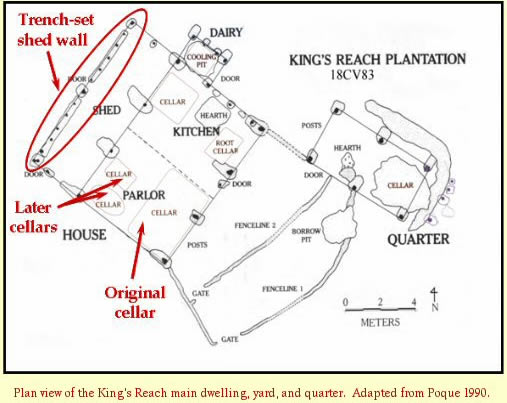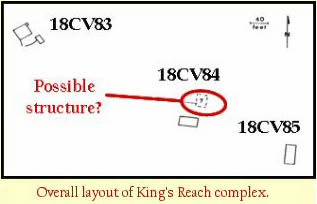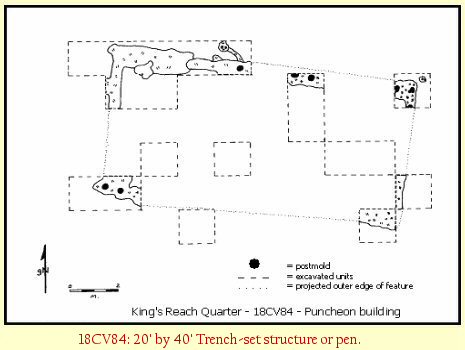17th & 18th Century Architecture Along the Patuxent River, MD
Essay by Sara Rivers Cofield, 2007
King's Reach Complex
The King’s Reach site (18CV83) is believed to be the c. 1690-1711 main dwelling of Richard Smith, Jr.’s plantation. Extensive excavations in 1984 and 1985 revealed a dwelling and quarter connected by fences. Rectangular structural postholes indicate sidewall construction for the 20’ by 30’, 3-bay main dwelling, with a 10’ by 30’shed along the northwest wall. The absence of artifacts in the post holes and trench fill of this shed indicate that it is original to the structure. The main house also had an attached dairy or buttery [17], plank floors, and six cellars, with the largest being the oldest. The excavation of new cellars after the walls of the original collapsed is indicative of their placement between floor-joists spaced at 5-foot intervals (Pogue 1990). There is no external chimney present, but the hearth appears to have been surrounded by a brick fireplace with an interior wood-framed mud-lined fire hood above (Ed Chaney, personal communication 2006; (http://www.chesapeakearchaeology.org/SiteSummaries/KingsReachSummary.aspx).
Pogue (1997) asserts that King’s Reach had a brick hearth, while architectural historians have argued that a full brick fireplace was present (Ed Chaney, Personal communication 2006).

Perhaps the most unusual architectural feature associated with the structure is the trench-set exterior wall of the shed. This wall is comprised of larger corner posts with trench-set studs measuring 5” to 7” in diameter and spaced at 2.5’ intervals. The trench is deeper than the bottom of the posts and the studs are not driven into subsoil. This type of construction appears elsewhere on the plantation as well.
Later excavations uncovered additional structures belonging to the plantation complex; a tobacco house with 1.3-1.6’ diameter posts comprising a 50’ by 24’ structure at least five bays long (18CV85) [18], and a quarter, outbuilding, or pen called the King’s Reach Quarter site. King’ Reach Quarter (18CV84; not to be confused with the quarter in the main dwelling’s yard) is a 20’ by 40’ structure that appears to have had all of its walls constructed with small trench-set posts similar to those of the shed. Scattered low-status domestic debris near the structure indicates that it may have been a slave or servant dwelling, though there is no evidence of a hearth, and one structural post hole discovered in the area may be evidence that there was another dwelling there that has not been explored through excavation. The possibility of another structure could explain the domestic debris if the trench-set building at King’s Reach Quarter is in fact just a large outbuilding or even a fenced enclosure of some sort (Ed Chaney, personal communication 2006).
 This type of trench-set post construction has been found on sites believed to have been inhabited by African slaves. At Yaughan plantation in South Carolina, for example, several structures had trench-set posts about 2.5’ apart. In these examples, however, the type of construction is associated with clay walls, and there is no evidence for such clay at King’s Reach. [19]
This type of trench-set post construction has been found on sites believed to have been inhabited by African slaves. At Yaughan plantation in South Carolina, for example, several structures had trench-set posts about 2.5’ apart. In these examples, however, the type of construction is associated with clay walls, and there is no evidence for such clay at King’s Reach. [19]

Another possible case for the influence of Africans can be seen in the quarter near the main dwelling at King’s Reach. This small 10’ by 20’ structure was built after the main structure and it has a hearth, but no chimney. [20] A drainage ditch along the north and east walls of the quarter helps tell the story of how the building was adapted because at some point the ditch was filled in, and a porch was added. Artifact disposal patterns support the presence of a door on this end of the dwelling.
The characteristics of this structure mirror those cited in Ferguson’s (1992:57) discussion of Kingsmill plantation’s dwellings with African adaptations. The small size, chimneyless hearth, and porch are all cited as compatible with African styles of living (Ferguson 1992). Although porches are also built by non-Africans, the presence of the porch on such a small quarter, and its placement on the end of the building with the most privacy for outdoor activities make this particular porch extra interesting. Plantation archaeologists have noted that slaves congregated their activities out of the viewscape of their owners and overseers as much as possible (Armstrong and Kelly 2000). Smith’s 1715 probate inventory lists 35 negro slaves and some of the slaves are described as "old" or "very old", so it stands to reason that they may have comprised part of the labor force involved in building and adapting the structures at King’s Reach.
Overall, however, African influences cannot explain all of King’s Reach’s unusual characteristics because many of the oddities have less to do with the architectural style than they are to do with the architectural quality not matching the wealth of the individual. King’s Reach exhibits an incredible array of high-quality ceramics and small finds that are indicative of Smith’s wealth, yet the home had ever-collapsing cellar walls, there were no tiles of any kind, only a few pieces of possible plaster, possibly no brick chimney, and a shed with a less-than-durable stud-in-ground wall. So why didn’t Smith invest more in the structures on the plantation?
King’s Reach was founded around 1689, which, as we already saw in the case of Nicholas Sewall, was a time of extreme political turmoil in Maryland because Protestant colonists joined forces to overthrow the Catholic proprietary. Smith was a Protestant supporter of Charles Calvert, and was repeatedly arrested or detained by fellow Protestants so that he that could not go to England or Maryland assembly meetings to speak on the Calverts’ behalf (http://www.chesapeakearchaeology.org/ SiteSummaries/KingsReachSummary.aspx). Additionally, the 1690s tobacco depression may have further discouraged quality infrastructure even for a man of Smith’s wealth.
Given this level of political and economic instability and Smith’s own uncertain position, it is understandable if he did not feel like channeling his resources into the highest quality buildings. He may not even have been around to supervise much of the construction if he was too busy getting arrested. This could explain many short-cuts that the builders might have taken, and it may also have afforded African laborers involved in construction more autonomy to influence the architecture than they otherwise might have had. [21]
If you have any questions or comments about this article, or sites and artifact collections discussed, please contact:
[email protected].